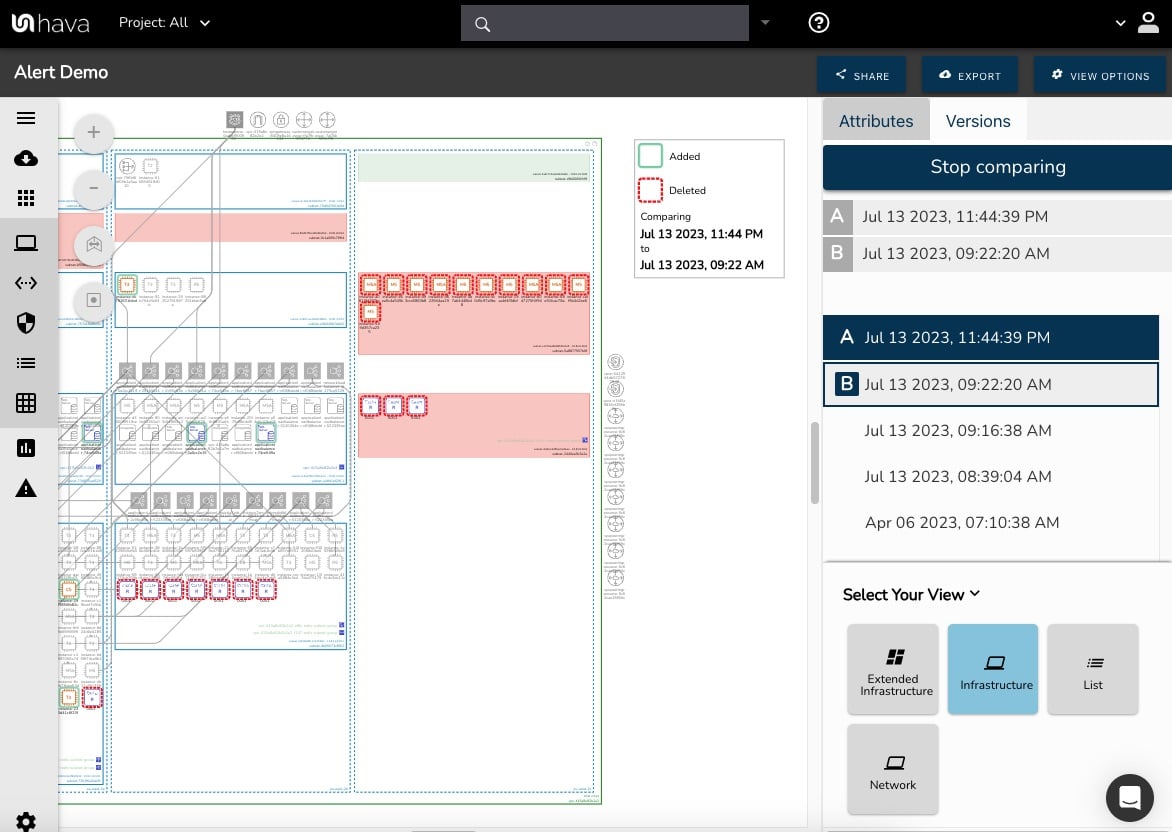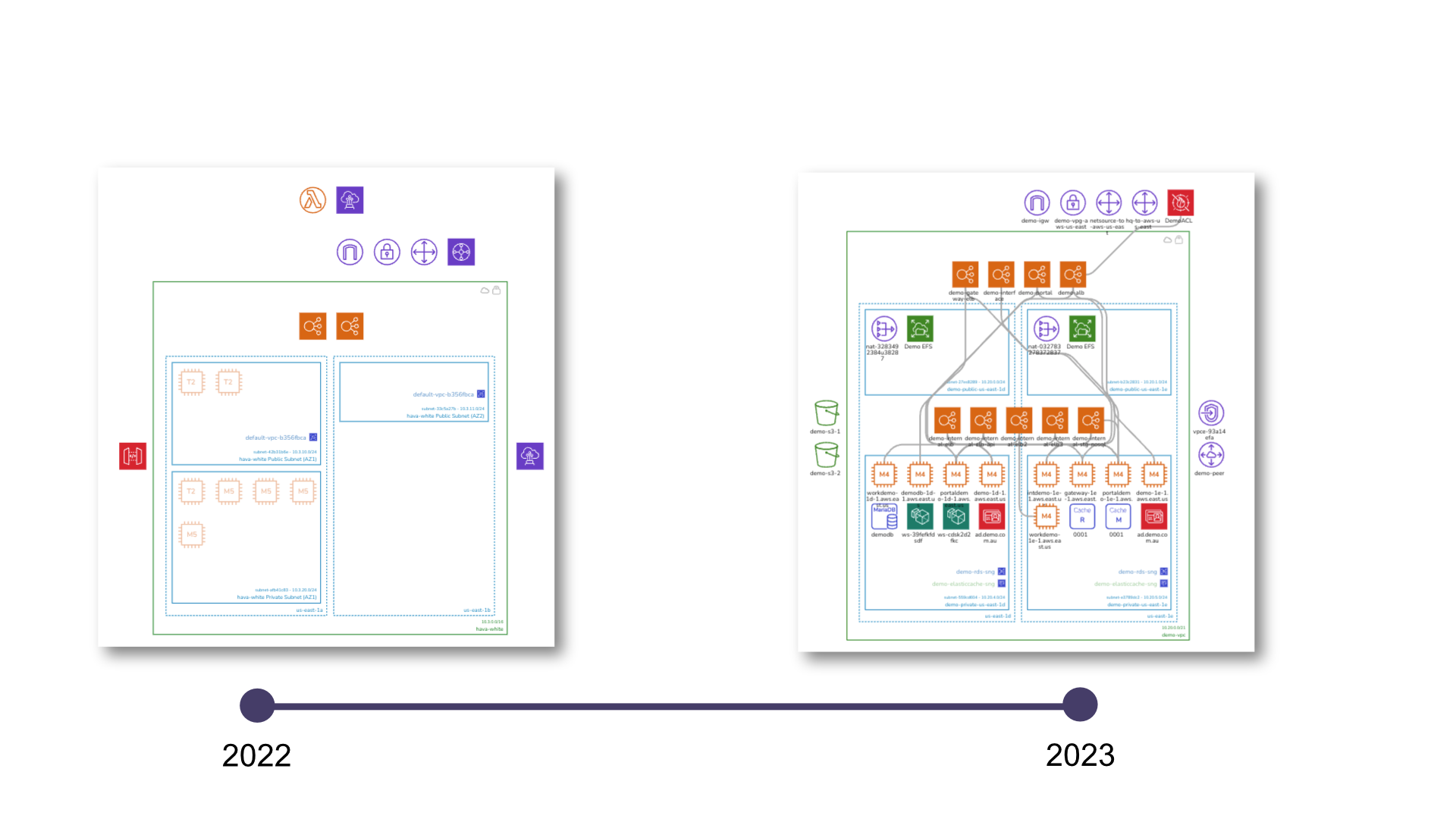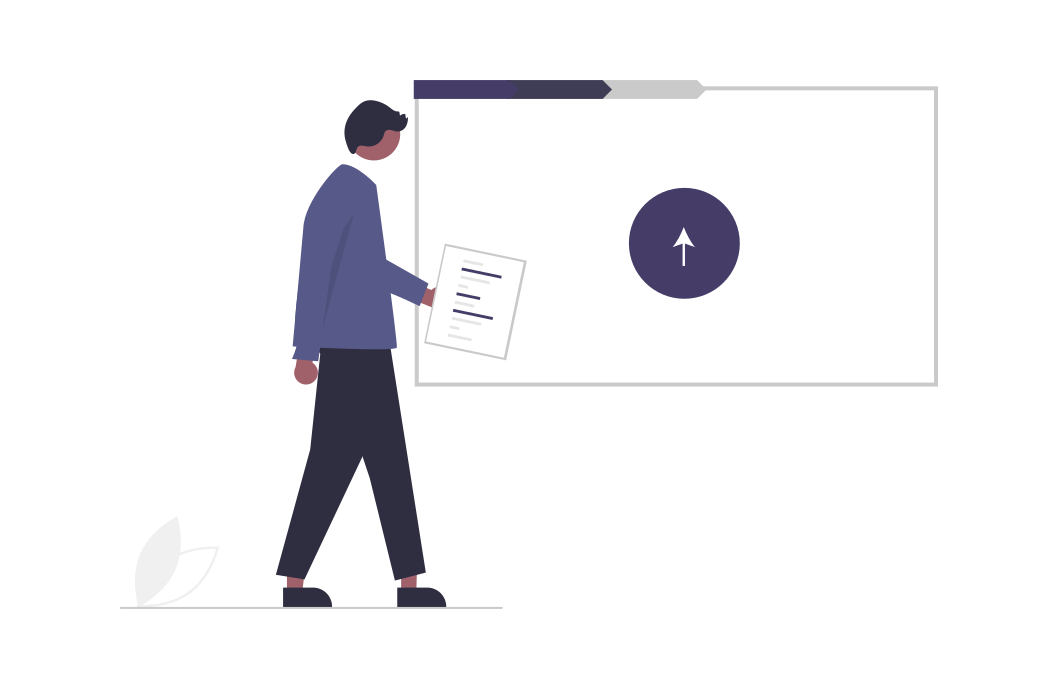2 min read
Pretty Architecture Diagrams Showing Poor Cloud Architecture Decisions
By Team Hava on Aug 17, 2023 4:51:00 PM
Topics: aws azure gcp FinOps
2 min read
Finding the Top 5 Culprits When Cloud Environment Costs Spike
By Alan Blackmore on Aug 7, 2023 4:26:00 PM
How to Find the Top 5 Culprits When Environment Costs Spike using Hava.io
Topics: aws azure gcp FinOps
2 min read
Strategies to Reduce Cloud Architectural Drift and Maintain Security
By Team Hava on Aug 7, 2023 6:00:00 AM
Cloud architectural drift, the divergence between the actual state of a cloud environment and its intended configuration, poses significant challenges to cloud security. It can lead to unauthorized changes, security vulnerabilities, and operational inefficiencies. Therefore, implementing strategies to minimize infrastructure resource drift is crucial for maintaining cloud security.
Firstly, adopting Infrastructure as Code (IaC) is a key strategy. IaC allows the infrastructure to be defined and managed as code, providing a consistent reference point for the desired state of the environment. Regularly running IaC scripts can automatically revert any unauthorized changes, effectively minimizing drift.
Secondly, implementing strict access controls can prevent unauthorized changes that lead to drift. By limiting who can make changes to the cloud environment and requiring approval for changes, organizations can maintain tighter control over their infrastructure.
Thirdly, regular auditing of the cloud environment is essential. Audits can identify changes that have occurred, allowing for the detection and remediation of drift. Tools that provide real-time visibility into the state of the infrastructure can be particularly useful for this purpose.
Additionally, fostering a culture of collaboration and transparency among development teams can help minimize drift. When teams understand the current state of the infrastructure and collaborate on changes, the risk of conflicting changes leading to drift is reduced.
Finally, continuous learning and improvement should be encouraged. As cloud environments and best practices evolve, strategies to minimize drift should be regularly reviewed and updated.
In conclusion, minimizing infrastructure drift is crucial for maintaining cloud security. By adopting IaC, implementing strict access controls, regularly auditing the environment, fostering collaboration, and encouraging continuous improvement, organizations can effectively manage drift and maintain a secure and efficient cloud environment.
Topics: aws azure gcp
2 min read
The Role of IaC in Managing Cloud Architectural Drift
By Team Hava on Aug 3, 2023 2:09:28 PM
Infrastructure as Code (IaC) is a key component in modern cloud environments. It allows developers to automate the provisioning and management of cloud resources using code, leading to more efficient and reliable deployments. However, when it comes to managing cloud architectural drift, IaC plays an even more critical role.
Cloud architectural drift refers to the divergence between the actual state of a cloud environment and its intended state as defined by IaC scripts. This drift can occur due to manual changes, conflicting IaC scripts, or other factors. If left unchecked, it can lead to security vulnerabilities, operational inefficiencies, and other issues.
IaC can help manage cloud architectural drift in several ways. Firstly, by defining the desired state of the cloud environment in code, IaC provides a clear and consistent reference point. Any deviations from this reference point can be easily identified, allowing for quick detection of drift.
Secondly, IaC enables automated remediation of drift. By running IaC scripts regularly, any changes to the cloud environment that were not made through IaC can be automatically reverted, bringing the environment back to its desired state. This not only reduces the risk of drift but also frees up valuable time for IT teams.
Finally, IaC promotes transparency and collaboration. With the entire infrastructure defined in code, it's easier for teams to understand the current state of the environment, track changes, and collaborate on updates. This can help prevent conflicting changes that could lead to drift.
In conclusion, IaC is an essential tool for managing cloud architectural drift. By defining the desired state of the cloud environment in code, enabling automated remediation, and promoting transparency, IaC can help organizations maintain control over their cloud environments, reduce risks, and improve operational efficiency.
Topics: aws azure gcp drift
2 min read
Understanding the Causes and Effects of Cloud Infrastructure Drift
By Team Hava on Aug 3, 2023 1:17:37 PM
Infrastructure drift is a common challenge faced by organizations that rely heavily on cloud services. It refers to the divergence of the actual state of cloud resources from their prescribed Infrastructure as Code (IaC) configuration. This drift can lead to potential security risks and operational challenges, making it crucial for businesses to understand its causes and effects.
The causes of infrastructure drift are varied and can occur due to several factors. Manual changes, such as configuration modifications, software updates, hardware malfunctions, and human error, can all lead to drift. These changes can impact the production environment, leading to discrepancies between the actual and intended state of the infrastructure.
Another common cause of infrastructure drift is conflicting Infrastructure as Code (IaC) code. This can occur when multiple development teams are working on the same infrastructure, leading to inconsistencies and drift. Poor practices, inappropriate permissions, and overlapping team boundaries can further contribute to drift. These issues can lead to unmanaged resources, creating a gap between the actual and desired state of the infrastructure.
The effects of infrastructure drift can be severe and far-reaching. Unmanaged drift can lead to security breaches, ransomware attacks, financial losses, increased resource costs, and increased support costs. It can also cause deployment failures due to configuration issues. These consequences can greatly affect critical cloud services and cloud security in cloud environments.
One of the key factors contributing to deployment failure is infrastructure drift. Therefore, managing infrastructure drift is essential to maintain system stability. Alterations to the configuration of code can potentially lead to infrastructure failure, causing infrastructure drift.
In conclusion, understanding the causes and effects of infrastructure drift is crucial for organizations relying on cloud services. By identifying the factors contributing to drift and the potential consequences of unmanaged drift, organizations can implement effective strategies to manage drift. This can help maintain the security and reliability of their cloud infrastructure, ensuring smooth operations and avoiding costly security breaches.
Topics: aws azure gcp msp managed service provider
2 min read
Scanning for and deleting unused cloud services - Hava brings context
By Team Hava on Jul 28, 2023 4:03:00 PM
Scanning for and Deleting Unused Cloud Services: A Key to Cost Efficiency with Hava.io
Topics: aws azure gcp FinOps
2 min read
How Hava.io's Version History Facilitates Better Cloud Architecture Management
By Team Hava on Jul 24, 2023 12:51:00 PM
For Cloud Managed Service Providers (MSPs), maintaining a thorough and up-to-date record of client documentation is paramount. Hava.io, an innovative cloud infrastructure visualization tool, offers a unique solution to this with its version history feature, bringing unprecedented clarity and continuity to cloud infrastructure management.
Topics: aws azure gcp diagrams msp managed service provider
2 min read
Untagged Filth be Gone - Save by Reducing Your Unused Cloud Services
By Team Hava on Jul 19, 2023 2:18:00 PM
Topics: aws azure gcp FinOps
2 min read
Leveraging Hava.io During the 4 Stages of Cloud Project Infrastructure
By Team Hava on Jul 14, 2023 1:50:18 PM
During a cloud project, keeping track of changes can be a daunting task. However, with the right tools, this process can be streamlined and made more efficient. One such tool is Hava, a robust platform designed to help teams understand and monitor changes in their cloud architecture.
Cloud infrastructure is a complex and dynamic entity. Changes, whether intentional or otherwise, can have significant implications, including ongoing costs, security considerations, and new maintenance tasks. These changes often occur behind the scenes, making them difficult to track and understand. This is even more prevalent during a cloud based project, whether it is your team or the client making changes. This is where Hava steps in, providing a clear and comprehensive view of your cloud architecture and its evolution.
Hava works by connecting to your cloud accounts and generating detailed infrastructure and security diagrams. These diagrams provide a snapshot of everything running in your environment, serving as a baseline for tracking changes. As new resources are added or existing ones are modified, Hava automatically updates these diagrams, ensuring you always have an up-to-date view of your infrastructure.
One of the unique features of Hava is its ability to monitor changes in real-time. With its built-in Architectural Monitoring, Hava can alert you when changes are detected in your environment. This allows you to stay on top of changes as they happen, enabling you to act quickly and make informed decisions.
Furthermore, Hava's integration with tools like GitHub and Confluence allows for seamless tracking of infrastructure changes during development cycles. With Hava, you can trigger a sync with GitHub to capture new environment diagrams as changes are pushed, and embed live interactive environment diagrams into Confluence pages for easy access and review.
In conclusion, Hava provides a powerful solution for monitoring cloud architecture changes. Its ability to generate detailed diagrams, track changes in real-time, and integrate with other tools makes it an invaluable asset for any team working with cloud infrastructure.
For a more detailed look at how Hava can help you track the stages of cloud architecture change during a project, refer to this blog post
Topics: aws azure gcp
2 min read
How to Build a Custom Diagram for Efficient Cloud Resource Management
By Team Hava on Jul 13, 2023 11:27:00 AM
In the complex world of cloud infrastructure, managing resources can be a daunting task. However, with Hava.io's custom search, you can build custom diagrams that simplify this process, making it easier to manage your resources efficiently.
Custom search is more than just a feature; it's a solution to the common problem of managing large and complex cloud environments. With Hava.io, you can build custom diagrams and quickly locate resources from hundreds of cloud accounts. This tool is especially useful when you need to find an individual resource, an IP address, or a VPC running in your managed environments.
One of the key benefits of Hava.io's custom search is its ability to create custom diagrams that self-update. This means you always have the most current view of your cloud infrastructure. Additionally, you can set up alerts for changes in your custom diagrams, keeping you informed and proactive.
But the power of custom search doesn't stop there. With Hava.io, you can also perform deep searches that not only bring back the resources that match your search but also anything connected to those resources. This is particularly useful when you want to see all the resources connected to a particular instance in your VPC.
In essence, Hava.io's custom search is a powerful tool that can transform your cloud management experience. It's about turning a sprawling cloud landscape into a navigable map, tailored to your needs. With Hava.io, you can harness the full potential of custom search, taking control of your cloud infrastructure like never before.
Ready to build custom diagrams for efficient cloud resource management? Dive into our detailed blog post to learn more about this game-changing tool.








